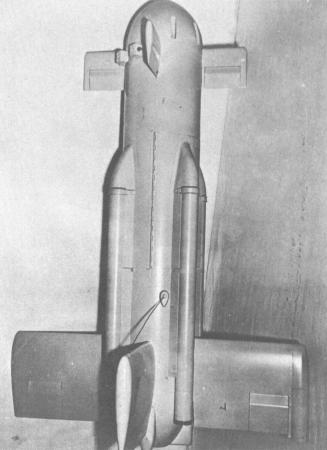NADC KAN Little Joe
In February 1945, the U.S. Navy had a very pressing requirement for a new air-defense weapon to counter the increasing Japanese Kamikaze threat more effectively than the existing anti-aircraft guns. Because the Lark missile project would need some time to develop a usable surface-to-air missile, the NAMU (Naval Air Material Unit) proposed the very simple Little Joe guided missile design as an interim weapon until Lark would become available. Little Joe was approved in May 1945, and the first test firing already occurred in July that year. In October 1945, the missile was designated as KAN-1.
The KAN-1 was basically an Aerojet 8AS1000 JATO (Jet-Assisted Take-Off) solid-fueled rocket fitted with cruciform wings and fins, and was boosted into the air by four auxiliary 76 mm (3 in) rockets. After launch, Little Joe was gyro-stabilized and could be radio-controlled by an operator who visually tracked the missile. Its 45 kg (100 lb) general-purpose warhead was triggered by a proximity (VT) fuze.
 |
| Photo: via Ordway/Wakeford |
| KAN-2 |
The KAN-2 model used a new propellant for the sustainer motor, which was presumably less smoking than the original one, because rocket smoke had significantly hampered tracking of the initial Little Joe missiles. The later models also had a flare in the tail to further facilitate optical tracking.
After the war had ended, 15 Little Joes had been built and tested. However, the need for a quickly available but very simple air-defense missile had effectively vanished, and therefore the Little Joe program was eventually cancelled in 1946. It is possible that preliminary provisions had been made for the production of Little Joe by Martin under the designation KAM-1, but this should be regarded as unconfirmed.
Specifications
Note: Data given by several sources show slight variations. Figures given below may therefore be inaccurate!
Data for KAN-1:
| Length | 3.45 m (11 ft 4 in) |
| Wingspan | 2.31 m (7 ft 7 in) |
| Diameter | 57.7 cm (22.7 in) |
| Weight | 550 kg (1210 lb) |
| Speed | 645 km/h (400 mph) |
| Ceiling | 2400 m (1.5 miles) |
| Range | 4 km (2.5 miles) |
| Propulsion | Sustainer: Aerojet 8AS1000 solid-fueled rocket; 4.4 kN (1000 lb) for 8 s Booster: 4x solid-fueled rocket; 4.4 kN (1000 lb) each for 1.25 s |
| Warhead | 45 kg (100 lb) high-explosive |
Main Sources
[1] Norman Friedman: "US Naval Weapons", Conway Maritime Press, 1983
[2] Frederick I. Ordway III, Ronald C. Wakeford: "International Missile and Spacecraft Guide", McGraw-Hill, 1960
[3] Bill Gunston: "The Illustrated Encyclopedia of Rockets and Missiles", Salamander Books Ltd, 1979
Back to Directory of U.S. Military Rockets and Missiles, Appendix 1
Last Updated: 15 February 2003